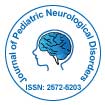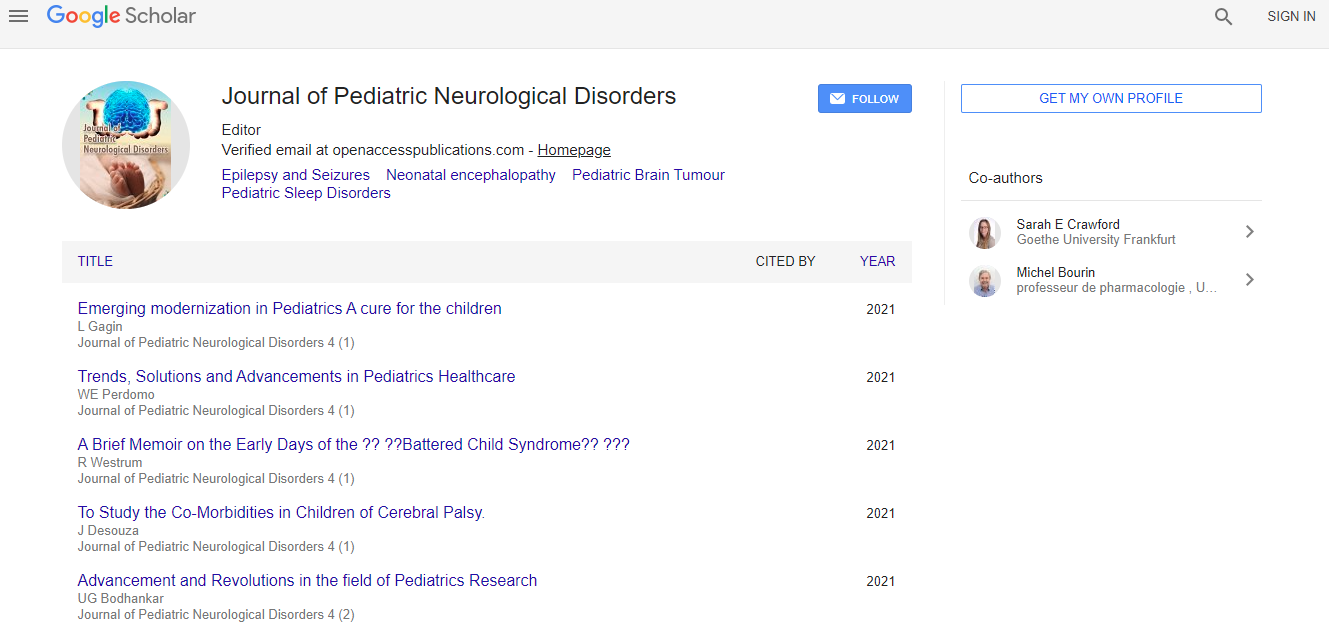Our Group organises 3000+ Global Conferenceseries Events every year across USA, Europe & Asia with support from 1000 more scientific Societies and Publishes 700+ Open Access Journals which contains over 50000 eminent personalities, reputed scientists as editorial board members.
Open Access Journals gaining more Readers and Citations
700 Journals and 15,000,000 Readers Each Journal is getting 25,000+ Readers
Google Scholar citation report
Citations : 3
Journal of Pediatric Neurological Disorders received 3 citations as per Google Scholar report
Indexed In
- RefSeek
- Hamdard University
- EBSCO A-Z
Useful Links
Share This Page
Editorial Board
Submit Manuscript
Submit manuscript at or send as an e-mail attachment to the Editorial Office at pediatricneurosci@omicsonline.org
If you are interested in publishing with us or have any questions, please feel free to contact us directly on WhatsApp .
Table of Contents
About the Journal
Journal of Pediatric Neurological Disorders is a peer-reviewed open access publication handled by OMICS International to present the latest developments in the field Neurology, Pediatric Brain Tumour, Neurodevelopment, Stokes and other areas of Neurological Disorders. This enables learners and academicians to gain access to instant and quick reference for the development of research in the field of Pediatric Neurology.
The peer-review process is designed to ensure the consistency of the submitted manuscripts in line with the set guidelines for a standard open access case report or research paper. The Journal of Pediatric Neurological Disorders has been acquired by OMICS International for dissemination of knowledge in the field of Neurology with provision of free sharing and transmission of articles under the norms of the Bethesda Statement.
Epilepsy and Seizures
Seizures, abnormal movements or behavior due to unusual electrical activity in the brain, are a symptom of epilepsy. Epilepsy is defined as a brain disorder characterized by an enduring predisposition to generate epileptic seizures and by the neurobiologic, cognitive, psychological, and social consequences of this condition. The clinical signs and symptoms of seizures depend on the location of the epileptic discharges in the cerebral cortex and the extent and pattern of the propagation of the epileptic discharge in the brain
Related journals for Epilepsy and Seizures:
Genetic Epilepsies
Genetic Epilepsies: Genetics play a part in many types of epilepsy. The concept of genetic epilepsy is that the epilepsy is, as best as understood, the direct result of a known or presumed genetic defect(s) in which seizures are the core symptom.
Related Journals for Genetic Epilepsies:
Journal of Neurophysiology, Progress in Neurobiology, Current Opinion in Neurobiology
Headaches and Migraines
Migraines are painful headaches often accompanied by nausea, vomiting, and sensitivity to light. Migraines and other types of headaches, such as tension headache and sinus headache, are painful. Migraine symptoms are treated with anti-nausea drugs and abortive or preventive medications. Headache remedies include pain relievers.
Related Journals for Headaches and Migraines:
PLoS Biology, Neuroscience, Journal of Comparative Neurology, European Journal of Neuroscience,
Genetic and Metabolic Disorders
Inherited metabolic disorders are genetic conditions that result in metabolism problems. A metabolic disorder occurs when the metabolism process fails and causes the body to have either too much or too little of the essential substances needed to stay healthyRelated journals for Genetic and Metabolic Dissorders:
Brazilian Journal of Medical and Biological Research:
CNS and Neurological Disorders - Drug Targets, Bulletin of Mathematical Biology, Journal of Physiology Paris, Journal of Neuroinflammation, Reviews in the Neurosciences, Psychiatry and Clinical Neurosciences
Stroke and Perinatal Injuries
Perinatal strokes are focal diseases of brain blood vessels that lead to injury in the brain during the fetal or newborn period. Diagnosis of perinatal stroke requires a careful assessment of both clinical factors and brain imaging by a specialist familiar with perinatal stroke. Some babies have symptoms in immediate time period (hours to days) after birth. These are most often seizures though other neurological concerns may be present. This in turn leads to imaging being performed that reveals the stroke
Related Journals for Stroke and Perinatal Injuries:
Brazilian Journal of Medical and Biological Research, CNS and Neurological Disorders - Drug Targets, Bulletin of Mathematical Biology, Journal of Physiology Paris, Journal of Neuroinflammation, Reviews in the Neurosciences, Psychiatry and Clinical Neurosciences
Neurodevelopmental Disorders
Neurodevelopmental disorders are impairments of the growth and development of the brain or central nervous system. A narrower use of the term refers to a disorder of brain function that affects emotion, learning ability, self-control and memory and that unfolds as the individual grows.
Related Journals for Neurodevelopmental Disorders:
Journal of the Peripheral Nervous System, Neurotoxicity Research, Expert Review of Neurotherapeutics, International Journal of Neuroscience
Congenital Brain Defects
Experimentalis, Autism Research, Neural Processing Letters, Neuroinformatics Congenital Brain Defects: Congenital brain defects are abnormalities in the brain that are present at birth. The defects typically affect the bone and soft tissue in the head and spine. There are many different types of these malformations. They can vary greatly from mild to severe conditions. A congenital brain defect usually occurs due to an interruption in the normal growth of the nervous system. The brain begins to form in the first month after conception. Development of the brain begins from a small, special plate of cells on the surface of the embryo. These cells grow and form the different regions of the brain. When this process is disturbed, it can cause structural defects in the brain and skull. Normal brain function can be impaired even if only the skull’s growth is upset.
Related Journals for Congenital Brain Defects:
Journal of Psychophysiology, Mathematical Medicine and Biology, Brain Stimulation, Frontiers in Neuroscience, Supplements to Clinical Neurophysiology, Behavioral Sleep Medicine, Functional Neurology
Movement Disorders
Movement disorders are neurological conditions that affect the speed, fluency, quality, and ease of movement. Abnormal fluency or speed of movement (called dyskinesia) may involve excessive or involuntary movement (hyperkinesia) or slowed or absent voluntary movement (hypokinesia). Common dystonias include spasmodic torticollis, which affects muscles of the head, face, and neck, and blepharospasm, which causes involuntary closing of the eyelids.
Related Journals for Movement Disorders:
Computation in Neural Systems, Current Neurology and Neuroscience Reports, Journal of ECT, Nutritional Neuroscience, Journal of NeuroImmune Pharmacology, DMM Disease Models and Mechanisms
Neuromuscular Disease
A neuromuscular disease is a disorder that affects the peripheral nervous system. The peripheral nervous system includes muscles, the nerve-muscle (neuromuscular) junction, peripheral nerves in the limbs, and the motor-nerve cells in the spinal cord. Other spinal cord or brain diseases are not considered “neuromuscular” diseases. Patients with neuromuscular diseases can have weakness, loss of muscle bulk, muscle twitching, cramping, numbness, tingling, and a host of other symptoms. Problems with the nerve-muscle junction can also cause droopy eyelids, double vision, and weakness that worsen with activity. Some neuromuscular disorders can also cause difficulty with swallowing and sometimes with breathing.
Related Journals for Neuromuscular Disease:
Translational Stroke Research, AJOB Neuroscience, F1000 Biology Reports, Current Protocols in Neuroscience, Neurology Psychiatry and Brain Research, Zhurnal Vysshei Nervnoi Deyatelnosti Imeni I.P. Pavlova
Pediatric Brain Tumour
A brain tumor is a collection (or mass) of abnormal cells in the brain. The skull is very rigid and the brain is enclosed, so any growth inside such a restricted space can cause problems. Brain tumors can be cancerous (malignant) or non-cancerous (benign). When benign or malignant tumors grow they can cause the pressure inside the skull to increase. This can cause brain damage and even death. Brain tumors are categorized as primary or secondary. Primary brain tumors originate in the brain. According to the University of Maryland Medical Center, about half of primary brain tumors are benign. Secondary brain tumors occur when cancer cells spread to the brain from another organ such as the lung or breast.
Related Journals for Pediatric Brain Tumor:
Journal of Vestibular Research: Equilibrium and Orientation, Acta Neurobiologiae Experimentalis, Autism Research, Neural Processing Letters, Neuroinformatics
Chiari malformation
Chiari malformation is a condition in which brain tissue extends into your spinal canal. It occurs when part of your skull is abnormally small or misshapen, pressing on your brain and forcing it downward. Chiari malformation is uncommon, but improved imaging tests have led to more frequent diagnoses. Chiari malformation type I develops as the skull and brain are growing. As a result, signs and symptoms may not occur until late childhood or adulthood. The most common pediatric form, called Chiari malformation type II, is present at birth (congenital). Treatment of Chiari malformation depends on the form, severity and associated symptoms. Regular monitoring, medications and surgery are treatment options. In some cases, no treatment is needed.
Related Journals for Chiari malformation:
Frontiers in Systems Neuroscience, Frontiers in Neuroanatomy, Journal of Visualized Experiments, Computational Intelligence and Neuroscience, Frontiers in Neural Circuits, Journal of Integrative Neuroscience
Neurological Complications of AIDS
AIDS is primarily an immune system disorder caused by the human immunodeficiency virus (HIV), but it can also affect the nervous system. HIV does not appear to directly invade nerve cells but it jeopardizes their health and function, causing symptoms such as confusion, forgetfulness, behavioral changes, severe headaches, progressive weakness, loss of sensation in the arms and legs, stroke, cognitive motor impairment, or damage to the peripheral nerves. Other complications that can occur as a result of HIV infection or the drugs used to treat it include pain, seizures, shingles, spinal cord problems, lack of coordination, difficult or painful swallowing, anxiety disorder, depression, fever, vision loss, gait disorders, destruction of brain tissue, and coma.
Related Journals for Neurological Complications of AIDS:
Experimental and Translational Stroke Medicine, Mind and Matter, Frontiers in Evolutionary Neuroscience, International Journal of Integrative Biology, Neuropsychopharmacologia Hungarica
Neurogenetic Disorders
Genetic disorders in children can have highly variable effects. Even relatively common disorders may go undiagnosed and untreated by clinicians who are not familiar with the range of "atypical" cognitive or behavioral symptoms possible in an affected child. Recent research in genetics and brain development has altered the phenotypic description of various disorders, but this new knowledge is not readily available to practitioners. This collection provides a single resource that will help clinicians, pediatricians, neuropsychologists, educators, and others use the latest research to identify and treat a variety of genetic disorders as early as possible.
Related Journals for Neurogenetic Disorders:
Psychology and Neuroscience, Handbook of Clinical Neurophysiology, Trends in Neuroscience and Education, International Journal of Intelligent Transportation Systems Research
Pediatric Sleep Disorders
Sleep disorders in children and adolescents are common; even infants may have sleep disorders. Studies have shown that poor sleep quality and/or quantity in children are associated with a host of problems, including academic, behavioral, developmental and social difficulties, weight abnormalities, and other health problems. Not only do pediatric sleep problems affect child health, but they can impact family dynamics and parental or sibling sleep. Children may suffer from problems falling or staying asleep; physiological problems such as obstructive sleep apnea abnormal or disruptive behaviors during sleep such as sleepwalking or other parasomnias symptoms that occur near sleep onset such as restless legs syndrome, and daytime symptoms such as excessive sleepiness, cataplexy and others. While adults may suffer from the same problems, the etiology, presentation, and associated findings in children may be very different than those seen in adults. In addition, developmental aspects of childhood play an important role in pediatric sleep, such as in the cases of early childhood insomnias and adolescent delayed sleep phase syndrome.
Related Journals for Pediatric Sleep Disorders:
Activitas Nervosa Superior Rediviva, Clinical and Experimental Neuroimmunology, Journal of Nanoneuroscience, Journal of Neurosciences in Rural Practice, Journal of Pediatric Neurosciences
Neonatal encephalopathy
Neonatal encephalopathy is a clinically defined syndrome of disturbed neurologic function in the earliest days of life in an infant born at or beyond 35 weeks of gestation, manifested by a subnormal level of consciousness or seizures, and often accompanied by difficulty with initiating and maintaining respiration and depression of tone and reflexes. This expanded clinical definition must be put into use based on measures that can be reliably and accurately implemented by trained staff. The first mandatory step in an assessment of neonatal encephalopathy is to confirm whether a specific infant meets the case definition.
Related Journals for Neonatal encephalopathy:
Journal of Experimental Stroke and Translational Medicine, Open Pain Journal, WSEAS Transactions on Biology and Biomedicine, Annual Review of CyberTherapy and Telemedicine, Brain connectivity, Journal of Mathematical Neuroscience, Noropsikiyatri Arsivi, Sleep Science, Avant
Journal Highlights
Fast Editorial Execution and Review Process (FEE-Review Process):
Journal of Pediatric Neurological Disorders is participating in the Fast Editorial Execution and Review Process (FEE-Review Process) with an additional prepayment of $99 apart from the regular article processing fee. Fast Editorial Execution and Review Process is a special service for the article that enables it to get a faster response in the pre-review stage from the handling editor as well as a review from the reviewer. An author can get a faster response of pre-review maximum in 3 days since submission, and a review process by the reviewer maximum in 5 days, followed by revision/publication in 2 days. If the article gets notified for revision by the handling editor, then it will take another 5 days for external review by the previous reviewer or alternative reviewer.Acceptance of manuscripts is driven entirely by handling editorial team considerations and independent peer-review, ensuring the highest standards are maintained no matter the route to regular peer-reviewed publication or a fast editorial review process. The handling editor and the article contributor are responsible for adhering to scientific standards. The article FEE-Review process of $99 will not be refunded even if the article is rejected or withdrawn for publication.
The corresponding author or institution/organization is responsible for making the manuscript FEE-Review Process payment. The additional FEE-Review Process payment covers the fast review processing and quick editorial decisions, and regular article publication covers the preparation in various formats for online publication, securing full-text inclusion in a number of permanent archives like HTML, XML, and PDF, and feeding to different indexing agencies.
h-index
Articles published in Journal of Pediatric Neurological Disorders have been cited by esteemed scholars and scientists all around the world. Journal of Pediatric Neurological Disorders has got h-index 1, which means every article in Journal of Pediatric Neurological Disorders has got 1 average citations.
Recently Published Articles
-
Canadian Practice Patterns of Venous Thromboembolism Prophylaxis for Adults with Spinal Cord Injury
Ethans K, Deng G, Townson A, Jacquemin G, Smith K, O'Connell C, Askari S and Ho C -
Neurosensorimotor Reflex Integration for Autism: a New TherapyModality Paradigm
Masgutova SK, Akhmatova NK, Sadowska L, Shackleford P and Akhmatov EA -
Genomewide Array Comparative Genomic Hybridization in 55 JapaneseNormokaryotypic Patients with Non-Syndromic Intellectual Disability
Miki Asahina, Yusaku Endoh, Tomoko Matsubayashi, Koichi Hirano, Tokiko Fukuda and Tsutomu Ogata -
Leber├ó┬?┬?s (plus?) Hereditary Optic Neuropathy: A Case Report
Arife CA, Cansu S and Ufuk E

 Spanish
Spanish  Chinese
Chinese  Russian
Russian  German
German  French
French  Japanese
Japanese  Portuguese
Portuguese  Hindi
Hindi 



